Cyber-crime investigation and the related legal framework are at a nascent stage in India. The NCRB data indicates that in 5 years between 2014 & 2018, there has been a fourfold increase in the number of pending cases in the courts as well as with the police.
Cyber-crime investigation and the related legal framework are at a nascent stage compared to most of the other crimes. It is all the truer in the case of India. Inclusion of provisions in IPC (Indian Penal Code) and SLL (Special and Local Laws) for crimes relating to the cyberspace is also relatively a recent development.
There are challenges not only in the identification and reporting of a cyber-crime but also in the investigation and disposal of such crimes.
In an earlier story of Factly, data relating to the cases of cyber-crimes registered and the types of such offences were analysed. This story is an analysis of the status of the cyber-crime cases and their disposal.
Increase in the number of cases Pending Investigation by Police
As highlighted in the earlier story, the number of cyber-crime cases registered annually is on the increase. However, the number of cases disposed of by the police annually is relatively low and as a result, the number of cases pending under various stages of investigation is increasing every year. An increasing number of pending cases are being carried forward to the following year.
- During the five-year period (2014-2018), the least number of cases disposed of was in the year 2016 (only 3,009), less than half the cases that were disposed of in the previous year i.e. 2015 (7,634 cases).
- The number of cyber-crime cases disposed of by police significantly increased in the next two years i.e. 13,996 and 17,378 in 2017 and 2018 respectively. However, they are less than the number of new cases registered during these two years ( 21,796 and 27,248 in 2017 & 2018 respectively).
- The number of cases pending investigation at the end of the year that were being carried forwarded had an increase from 8,049 cases in 2014 to 32,482 in 2018.
The annual increase in the pendency has been specifically high in 2017 and 2018.
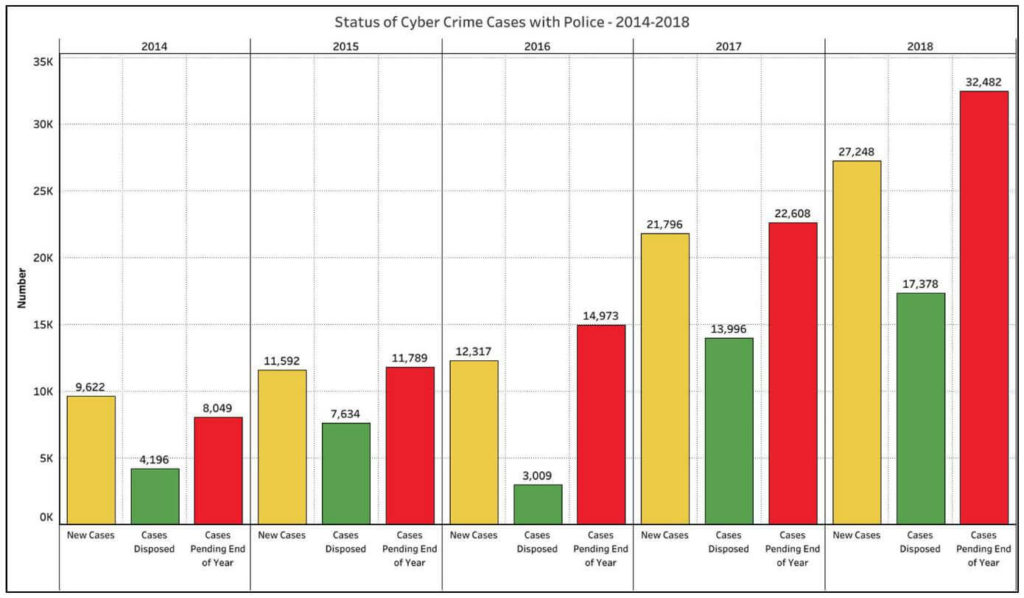
The Pendency percentage, defined as the share of total cases that are pending investigation at the end of the year out of the total cases under investigation (includes – cases from the previous year, new cases in current year & cases re-opened for investigation), has also increased considerably in 2018. The pendency stood at 65.1% in 2018 compared to that of 61.7% in 2017.
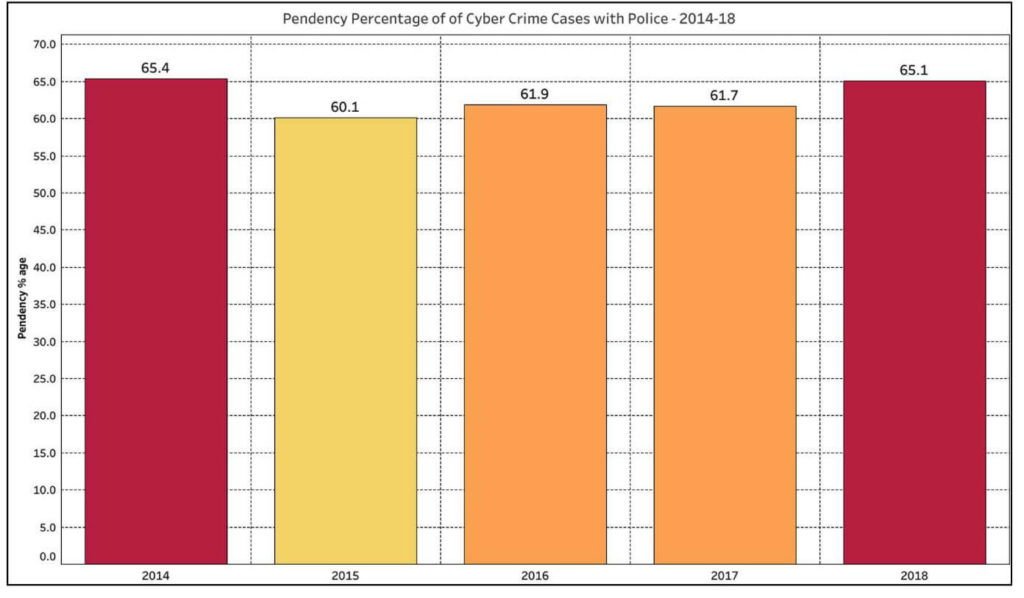
Apart from higher pendency of cases, a major portion of the cases disposed of by police are the ones whose investigation was closed, and the charge sheet not filed for further process.
Lack of evidence is main reason for closure of cases by Police
Out of 17,378 cases that were disposed of by police in 2018, a total 7,234 have been charge-sheeted and in 10,092 cases were closed by submitting the final report. ‘Cases True but Insufficient Evidence or Untraced or No Clue’ is cited as the major reason for closing the case by police with 8,604 cases being closed with this reason. This is also the main reason for closure of the cases by police even during the earlier years – 7,333 in 2017 and 1,749 in 2016.
A further 1,024 cases of cyber-crime were closed by the police citing ‘Cases Ended as Mistake of Fact or of Law or Civil Dispute’.
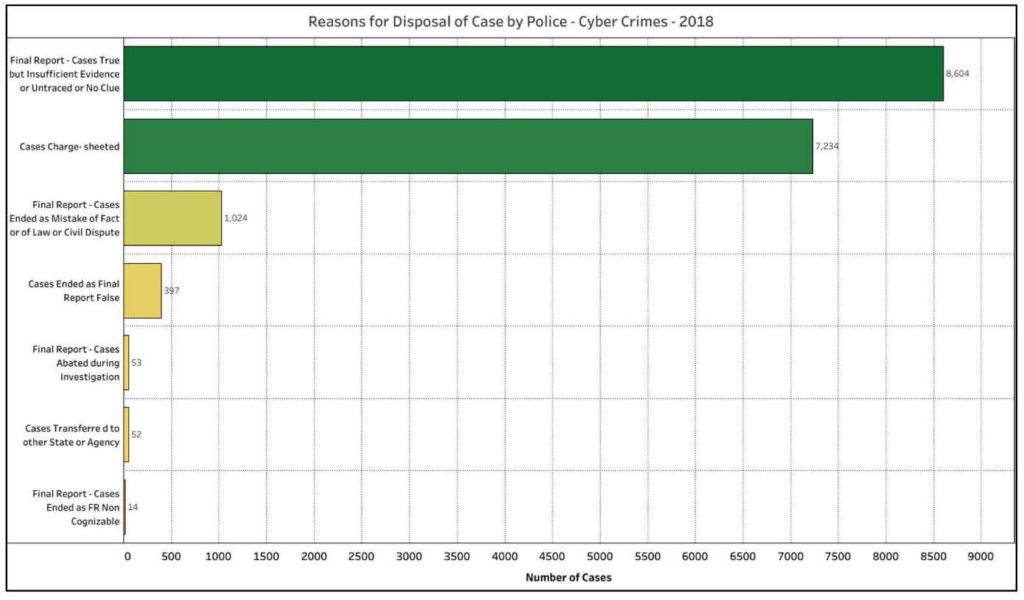
Charge sheeting rate slightly improved in 2018
The charge sheeting rate (defined as the share of cases which have been charge-sheeted out of the total cases disposed of by the police) for cyber-crimes in 2018 was 41.6 %, better than that of 2017 when it was 37 %. However, this slight improvement is after a continuous fall over the previous three years. In 2014, the charge sheeting rate was 57%, prior to the slide in subsequent years.

Cyber-crimes booked under section of the IPC and SLL have better charge sheeting rates when compared to that of cases under IT Act. In 2018, 39.4% of cases booked under IT Act were charge-sheeted, whereas it is 45.3% and 70.1% for cases under IPC and SLL respectively. Similar trend was observed even in the previous years. However, it has to be noted that the number of cases booked under IT Act is more than the ones booked under IPC and SLL.
Higher pendency in cases relating to Identity theft and Cheating
In 2018, 85.4% of the cases booked for ‘Identity Theft’ are pending i.e. a total of 8649 of the cases 10,124 cases to be investigated in the year. Further, 4332 cases out of total 5865 related to Cheating are pending investigation i.e. 73.9%.
Among other major crime heads, 64.8% of the crimes related to ATM fraud, 55.6% for crimes related to ‘publication/transmission of obscene/sexually explicit act in electronic form’ are pending investigation by police.

More than fourfold increase in the pendency in Courts
During 2014, 2116 new cases were sent to the court for trials which increased in the subsequent years – 3206 (2015), 3712 (2016), 5180(2017) and 7234 (2018). However, the number of cases in which the trial was completed has not increased proportionally. In fact, in 2017, trial was completed in only 674 cases, less than the number in 2016.
By the end of 2018, a total of 18,966 cases of cyber-crimes were pending at the trial stage, which is more than a fourfold increase compared to the number of cases pending for trial by the end of 2014, when it was just 3,957.
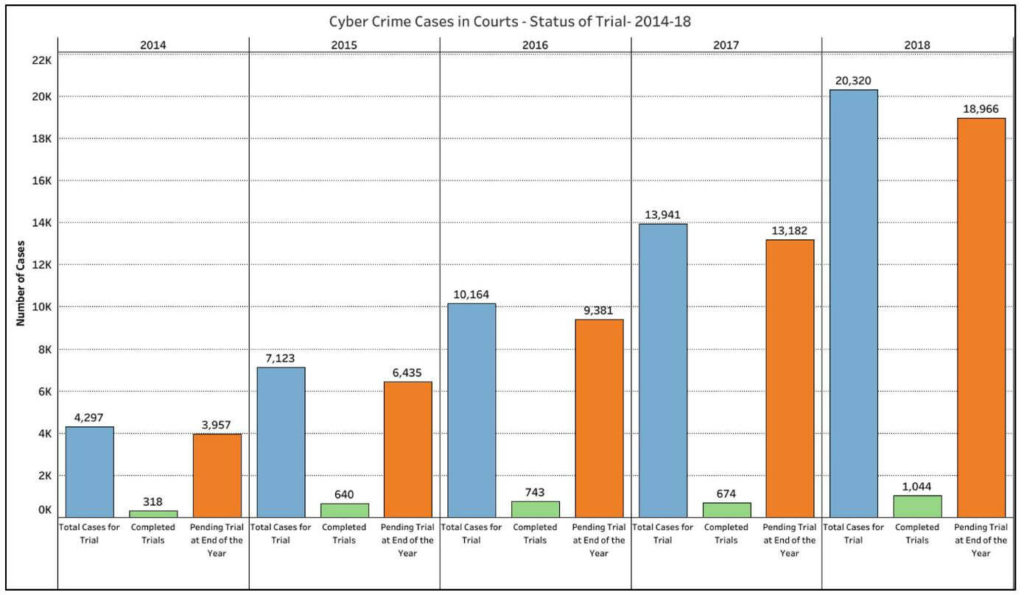
Sharp increase in the number of Convictions in 2018
Among the cases of cyber-crimes that have completed trial in courts, the number of cases which have resulted in acquittal has been proportionately higher than the ones that resulted in a conviction. Even in 2018, the number of cases that resulted in a conviction is less than the ones that ended in acquittal. However, the difference between these two figures has significantly reduced compared to that of previous years. The number of convictions in cyber-crime cases in 2018 was 495, highest during the 5-year period of 2014-18.
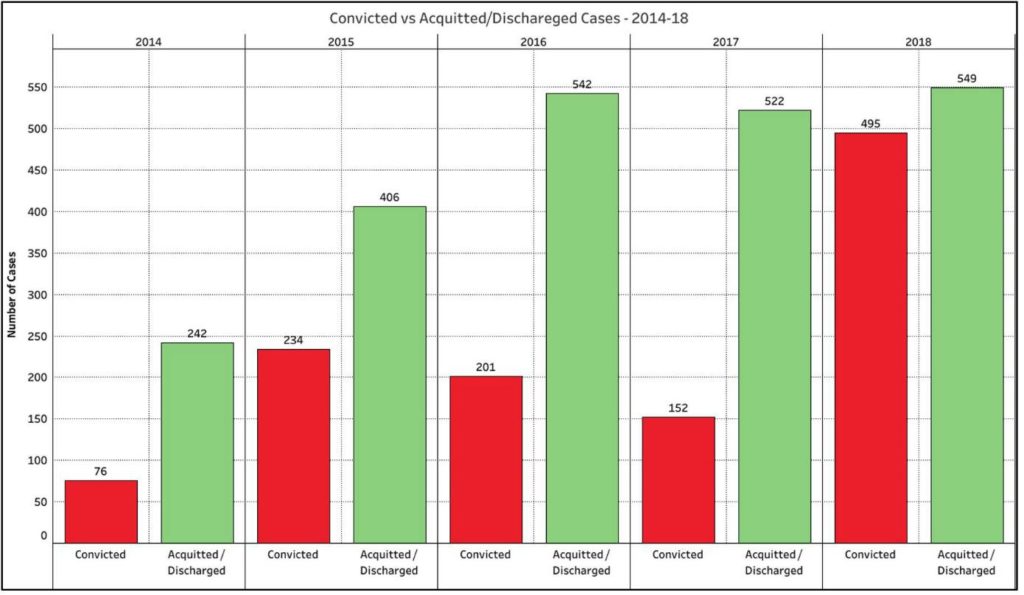
Pendency, an issue with both the police and the courts
The cases pending investigation with police and pending trial with courts have increased over the years. Both have increased more than fourfold between 2014-2018. While the increase in the number of new cases could be one of the contributing factors, data indicates that lower disposal rate is the prime reason for increasing pendency in cyber-crime cases.
A majority of the cases that are being disposed of by police are due to lack of evidence and the majority of the ones disposed of by the courts are resulting in acquittals. More granular data related to reasons for acquittal as well as pendency in courts can provide more insights on this dismal state of affairs.
Featured Image: Pendency in Cyber-Crime cases


